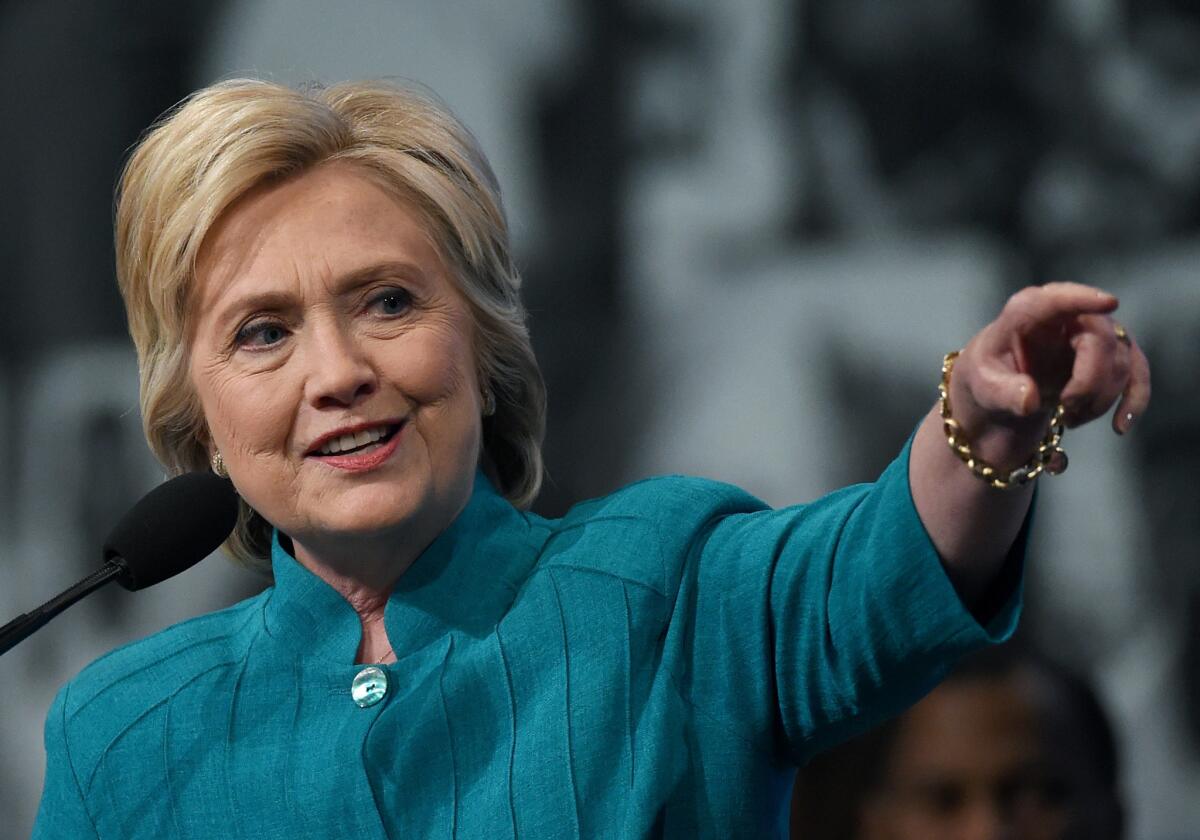Commentary: Examining the âintersectionalityâ of the Clinton candidacy

Democratic presidential candidate Hillary Clinton speaks at the American Federation of State, County and Municipal Employees 42nd International Convention at the Las Vegas Convention Center on July 19, 2016.
The theoretical notion of âintersectionalityâ was recently revisited by civil rights advocate Kimberlé Crenshaw in her 2015 Washington Post essay, âWhy Intersectionality Canât Wait.â Crenshaw makes a case for using intersectionality, as a framework, for analyzing racial, sexual and economic justice âthe very issues that are at the forefront of this yearâs presidential election.
âIntersectionality was a lived reality before it became a term,â she writes.
At the end of the day, when individuals are supporting, or not supporting, a political candidate, our voting choices are informed by our lived realities.
What is clear in adopting an intersectional feminist approach to discussing societyâs most pressing issues, is that one must attempt to understand how some categories are more salient and interact with other identity categories. However, when one analyzes the mainstream media framing of the current presidential election, this nuanced analysis is lacking. Perhaps most clearly is this lack seen in the dominant discourse surrounding Hillary Clintonâs bid to shatter the glass ceiling and become the first female president.
Join the conversation on Facebook >>
The centering of gender simultaneously de-centers other critical categories of analysis critical to the populous voting bloc in decision-making processes, and renders other, more critical, explanations for Clintonâs âwomen problemâ invisible.
First, we must interrogate the premise that Clinton does, in fact, have a âwomen problem,â when it comes to female voters. When analyzing the most recent credible presidential polls, Clinton holds strong favorable margins across conservative, liberal and independent polls above Donald Trump.
However, when you break the polling down to young female voters, differences across those aforementioned intersectional categories, begin to emerge. Many more middle-aged, or older, women support Clinton, versus millennial female voters, who were zealot Bernie Sanders-or-bust supporters.
The task for the Clinton camp is to attempt to understand these reported ideological voting disconnects. Some pundits have claimed that the female generational gap among potential Clinton supporters is due to young women not viewing themselves, or identifying as, feminists.
However, these claims are disputed by a Kaiser Family Foundation-Washington Post national survey conducted in January that found 6 in 10 women, and one-third of men, call themselves a âfeminist,â or âstrong feminist,â with roughly 7 in 10 of each reporting the feminist movement as âempowering.â
So why the gender divide? First, we must remember that there are many different types of feminisms. This poll does not ask respondents to list what type of feminism they ascribe to. In addition, feminism is not just a label; it is an identity and an analytic category used to make sense of lived experiences.
As such, young women do not always have as much life experience in relation to workplace discrimination or childcare challenges. Issues of economic justice, which poll as important to young, female voters, were dominated by Sanders. With Sanders out, Clintonâs platform must embrace the economic concerns of young women and women of color.
Clinton is beginning to see the necessity of nuanced analysis. Recently, her team hired three former Sanders aides to spearhead an effort to bridge this gap and also unveiled a college affordability plan. We see a move beyond gender to attempt to address economic justice. We also see a (perhaps) not-so-subtle shift of Clintonâs departure of her comfort zone discourses of âbattles of the sexesâ to discourses on racial and economic justice in relation to privilege.
So, yes, Clinton would be our first female president. But theories of intersectionality and feminism seek to understand what type of female president. When that question is answered, we are left with the stark image of a privileged, white, rich, straight woman.
Viewed through this lens, not only is Clintonâs gender not enough to secure the young womenâs vote, it may be a negative. The limits of gender, as a driving category, are brought to bear when they intersect with her record on issues that permeate the categories of race, class and sexuality.
Issues such as trans-phobia, the prison pipeline, imperial wars, are not only categories of non-support, but also categories that function as warrants for claims and campaigns against. Young voters are disenfranchised with the system, itself, that propels Clinton as a candidate.
Perhaps, instead of asking why Clinton has a âfemale voter problem,â a more important question to ask may be: in the shattering of this glass ceiling, who has been damaged by the falling shards, and, who will be left picking up the thousands of shattered pieces on Nov. 9?
Editorâs note: This was an abridged version of a longer piece written for the Huffington Post and reprinted here with permission. The full-length piece can be read at https://tinyurl.com/hx7mkb6
--
Costa Mesa resident NINA M. LOZANO-REICH is an assistant professor of communication studies at Loyola Marymount University, Los Angeles.